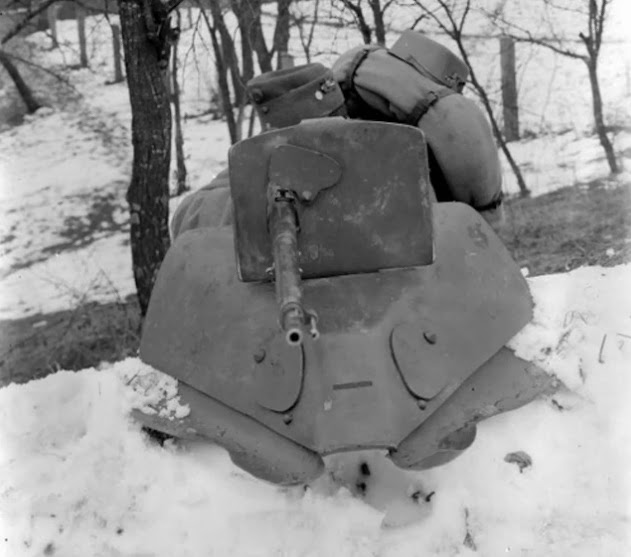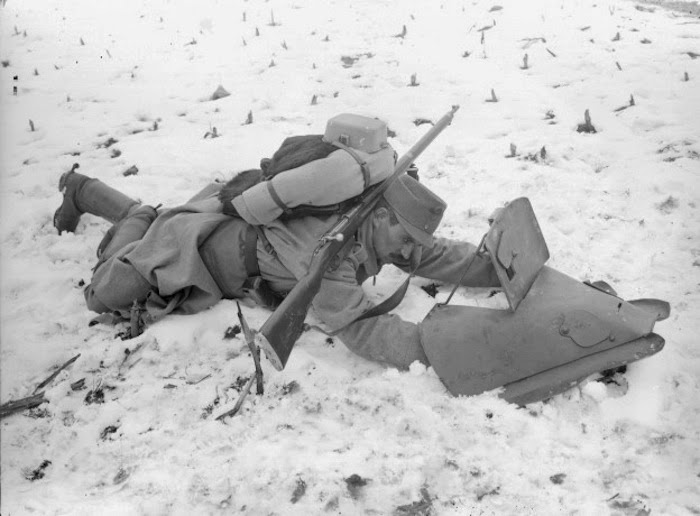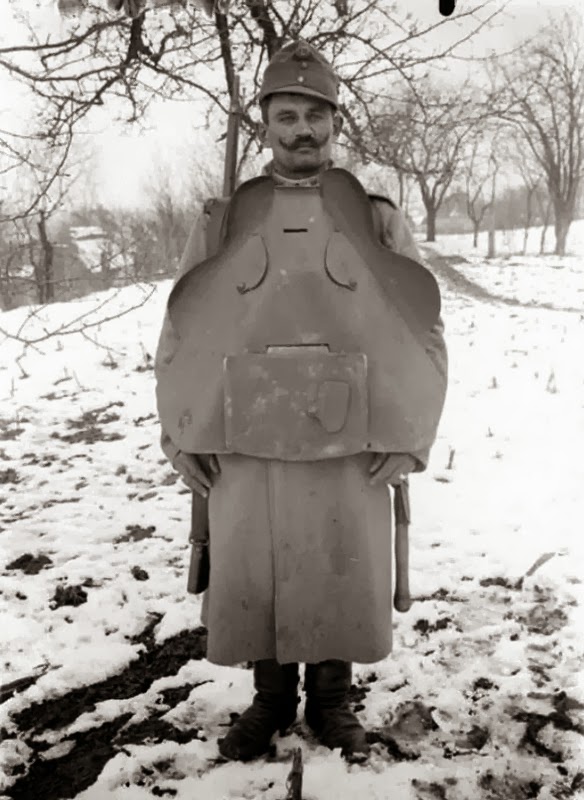I am blatantly swiping this set of photos from a neat (and fairly new) blog I stumbled across, entitled Soviet Gun Archives. There aren’t a whole lot of posts there yet, but they cover some excellent material.
As for this post, it’s on the subject of Austrian WWI metal body armor. Several countries experimented with the idea, the most well-known probably being the German machine-gunner’s armor. Well, this Austrian setup is a bit awkward for general use:
However, it isn’t designed for just running around in. The whole point is that you can take it off, fold the side under, open the little hatch, and have a handy portable pillbox!

It only protects from the front, though, so it’s vital that you not get flanked – or attacked with explosives.

No word on whether this was ever produced in quantity or saw any real combat use.


http://en.wikipedia.org/wiki/Pavise – the Austrian one is niftier with all that folding, but it lacks the paintings common on the classic models 😉
I think these did see some combat use. The Austrian Bundesheer museum in Vienna has an outstanding collection, and there are several big coffee table books with detailed color photos of Austrian equipment and weapons.
http://www.militaria.at/Book.aspx?bo…00&Language=de
I just read the storm troops edition from the series and apparently such armored plates were to be left behind in trenches and emplacements on the Italian front when troops rotated out of the line [I’m sure the soldiers were mighty glad to leave heavy stuff of dubious value behind!] In addition, such plates were apparently employed so that riflemen could cover other soldiers with wire cutters removing obstacles, or digging sap lines or communication trenches. Admittedly, an odd artifact of trench warfare.
On a side note, his mustache is designed to capture and deflect bayonets.
I knew there had to be a good reason for those mustaches! 🙂
I was waiting for this comment!
I’ve read of the Prussian military fashion in the Napoleonic era of using tar to stiffen/ shape mustaches…. looks like that fashion may have been in use a century later!
It looks suspiciously like it was originally intended for EOD work. the conical shape would be reasonable for someone to crawl up to a “dud” shell or etc., pushing it ahead of him. The conic section would deflect much of the blast in open air.
Of course, if you’re working around it with your hands stuck out, there’s a good chance you’d lose them, too.
cheers (?)
eon
From what I’ve read EOD work at the time amounted to clearing people out and chugging a hand grenade at the offending dud.
Personally I think the little shutters on the front is so you can get your hands out and cut barbed wire barriers. There’s even a little viewing slit to see through while you’re lying in the mud.
Sounds about right. Who wants to cut wires or disarm mines while under fire? And how about an armored sled that can have wheels attached to go with this shield? Then you wouldn’t have to worry about getting bayoneted in the flank. Upon seeing the bottom photo, I was actually tempted to impale the guy with a saw-backed engineer’s bayonet before he could get up.
Considering how barb wire barriers were set up there wouldn’t be much danger of being bayoneted. Those only came out once you were into the trench. And that less and less as the war progress and they learned how to do defence in depth.
Photos of WW1 infantry shields: http://gizmodo.com/5845628/how-to-bulletproof-yourself-on-a-wwi-battlefield/
And don’t forget about Hughes shovel:
http://en.wikipedia.org/wiki/MacAdam_Shield_Shovel
Ordnance officers certainly can’t think logically – they should try to dig out trench with this “genius” tool, before ordering 25,000 pieces…
Looks like a more man-portable version of the French ‘Mobile personnel shield’.
http://en.wikipedia.org/wiki/Mobile_personnel_shield
I’m surprise the URL http://sovietguns.blogspot.com was even Availible.
Did these shield actually do anything against a rifle bullet? I don’t think they used AP in WWI, but still, probably needs to be 3/8″ thick to do something, that stuff is heavy, 15 lb/sft
Given how much it slopes I doubt you’d need much to deflect a rifle calibre bullet.
I expect it would stop a bullet. I happen to have firsthand experience of firing a .236 Lee Navy round into an SG43 carriage shield at basically point-blank range (not my finest moment) and it survived with a small dimple. That was WWII armor rather than WWI, but I would be pretty surprised if this armor wouldn’t have protected from moderate ranged FMJ at least.
Maxim and SG-43 gunshields were proofed to 7.62x54R heavy ball @ point blank.
This bloc is EPIC, thanks for sharing!
Plagiarism; “This bloc is EPIC, thanks for sharing!” But great in it’
s own right.
I think Thiel brought up a pretty good point about the sloped armor of this device when used in the folded position. Sloping certainly helps a great deal in deflecting projectiles and/or limiting their penetration, and lends a much greater level of protection to a given thickness of armor plate.
I also noticed that when this Austrian armor is deployed in the full-frontal position ( as seen on the soldier standing in the upright position in the first photograph ), the designers had obviously taken into account complete protection for the torso extending to the arms, albeit at the cost of added bulk and weight.
Sloped armor made its way to tanks, so I’m not surprised. Sloping the armor increases the effective armor thickness relative to a projectile coming at the usual firing trajectory (not a path normal to the surface of the armor in question once it is sloped, but perpendicular to the plate should it not have been sloped). The issue I have with this type of armor is that it is more defensive than offensive, as I can hardly imagine anyone crawling through mud with this heavy thing. But the offensive armor concept is what eventually resulted in tanks coming about. In fact, at least one French commander contemplated the idea of a mechanized mobile heavy armor in 1914, though the issues of technological development were to delay the tank for quite some time…
Before machine guns were used by 2 first-class nations against each other for the first time, armies never crawled, they marched. When WWI came about, armor such as this was devised to allow soldiers to keep marching like they had for centuries. It did not work out that way, however.
Actually, I’m pretty sure this armour is designed to crawl with. Being able to walk with it and still get a modicum of cover out of it is likely just a bonus.
I’m guessing they were intended for advance wire cutting parties who’d crawl out into no man’s land before an attack to try and clear a path through the enemy’s wire barriers.
The holes with sliding covers at the top looks large enough to get your hands out through so you can use a wire cutter while lying down on your stomach. That would also explain the vision slit.
The sitting position would presumably be used by the wire cutter’s squad mates who’d sit a bit further back and provide cover in case they’re spotted.
At least that’s my take on it.
Speaking of sloped armor for tanks and other AFV’s, armored vehicle construction technologies generally did not advance sufficiently to allow mass production of armored vehicles with all-around sloped armor until well after the beginning of the Second World War, and by the time sloped armor came into general front-line use with the combatants who had sufficient foresight to incorporate it in their designs, it was already about the middle of the war. As a result of this lag time and the inevitable exigencies of war, many Allied and Axis AFV’s based on the older “armored box” design with vertical armor plate continued to be manufactured and put into service until the war’s end.
Indian Armour offers light weight ballistic helmets with level IIIA protection under NIJ standard 0106.01. Specially engineered to ensure best protection, maximum comfort and flexibility.
Indian Armour offers light weight ballistic helmets with level IIIA protection under NIJ standard 0106.01.
Specially engineered to ensure best protection, maximum comfort and flexibility.
https://www.indianarmour.com/Ballistic-Helmets.html
Nowadays body Armour has Evolved in so much advanced version.
Now Kevlar is the revolutionary Fabric which Stops Bullets..
Here is one of the best manufacturers and suppliers of body armour in UAE and USA
https://www.hardshell.ae/body-armour/
https://www.hardshell.us/